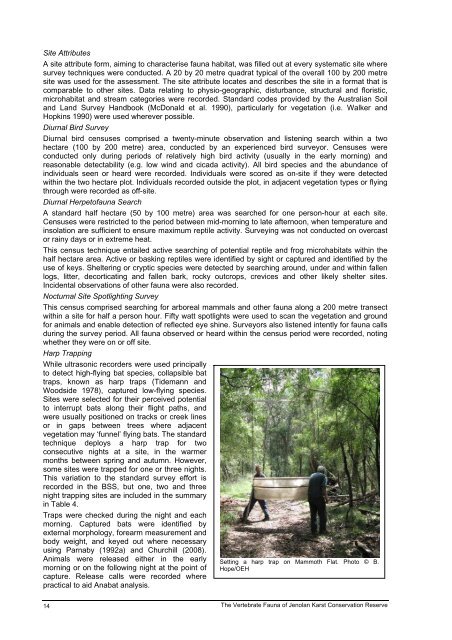The Vertebrate Fauna of Jenolan Karst Conservation Reserve: Final
The Vertebrate Fauna of Jenolan Karst Conservation Reserve: Final
The Vertebrate Fauna of Jenolan Karst Conservation Reserve: Final
Create successful ePaper yourself
Turn your PDF publications into a flip-book with our unique Google optimized e-Paper software.
Site Attributes<br />
A site attribute form, aiming to characterise fauna habitat, was filled out at every systematic site where<br />
survey techniques were conducted. A 20 by 20 metre quadrat typical <strong>of</strong> the overall 100 by 200 metre<br />
site was used for the assessment. <strong>The</strong> site attribute locates and describes the site in a format that is<br />
comparable to other sites. Data relating to physio-geographic, disturbance, structural and floristic,<br />
microhabitat and stream categories were recorded. Standard codes provided by the Australian Soil<br />
and Land Survey Handbook (McDonald et al. 1990), particularly for vegetation (i.e. Walker and<br />
Hopkins 1990) were used wherever possible.<br />
Diurnal Bird Survey<br />
Diurnal bird censuses comprised a twenty-minute observation and listening search within a two<br />
hectare (100 by 200 metre) area, conducted by an experienced bird surveyor. Censuses were<br />
conducted only during periods <strong>of</strong> relatively high bird activity (usually in the early morning) and<br />
reasonable detectability (e.g. low wind and cicada activity). All bird species and the abundance <strong>of</strong><br />
individuals seen or heard were recorded. Individuals were scored as on-site if they were detected<br />
within the two hectare plot. Individuals recorded outside the plot, in adjacent vegetation types or flying<br />
through were recorded as <strong>of</strong>f-site.<br />
Diurnal Herpet<strong>of</strong>auna Search<br />
A standard half hectare (50 by 100 metre) area was searched for one person-hour at each site.<br />
Censuses were restricted to the period between mid-morning to late afternoon, when temperature and<br />
insolation are sufficient to ensure maximum reptile activity. Surveying was not conducted on overcast<br />
or rainy days or in extreme heat.<br />
This census technique entailed active searching <strong>of</strong> potential reptile and frog microhabitats within the<br />
half hectare area. Active or basking reptiles were identified by sight or captured and identified by the<br />
use <strong>of</strong> keys. Sheltering or cryptic species were detected by searching around, under and within fallen<br />
logs, litter, decorticating and fallen bark, rocky outcrops, crevices and other likely shelter sites.<br />
Incidental observations <strong>of</strong> other fauna were also recorded.<br />
Nocturnal Site Spotlighting Survey<br />
This census comprised searching for arboreal mammals and other fauna along a 200 metre transect<br />
within a site for half a person hour. Fifty watt spotlights were used to scan the vegetation and ground<br />
for animals and enable detection <strong>of</strong> reflected eye shine. Surveyors also listened intently for fauna calls<br />
during the survey period. All fauna observed or heard within the census period were recorded, noting<br />
whether they were on or <strong>of</strong>f site.<br />
Harp Trapping<br />
While ultrasonic recorders were used principally<br />
to detect high-flying bat species, collapsible bat<br />
traps, known as harp traps (Tidemann and<br />
Woodside 1978), captured low-flying species.<br />
Sites were selected for their perceived potential<br />
to interrupt bats along their flight paths, and<br />
were usually positioned on tracks or creek lines<br />
or in gaps between trees where adjacent<br />
vegetation may ‘funnel’ flying bats. <strong>The</strong> standard<br />
technique deploys a harp trap for two<br />
consecutive nights at a site, in the warmer<br />
months between spring and autumn. However,<br />
some sites were trapped for one or three nights.<br />
This variation to the standard survey effort is<br />
recorded in the BSS, but one, two and three<br />
night trapping sites are included in the summary<br />
in Table 4.<br />
Traps were checked during the night and each<br />
morning. Captured bats were identified by<br />
external morphology, forearm measurement and<br />
body weight, and keyed out where necessary<br />
using Parnaby (1992a) and Churchill (2008).<br />
Animals were released either in the early<br />
morning or on the following night at the point <strong>of</strong><br />
capture. Release calls were recorded where<br />
practical to aid Anabat analysis.<br />
14<br />
Setting a harp trap on Mammoth Flat. Photo © B.<br />
Hope/OEH<br />
<strong>The</strong> <strong>Vertebrate</strong> <strong>Fauna</strong> <strong>of</strong> <strong>Jenolan</strong> <strong>Karst</strong> <strong>Conservation</strong> <strong>Reserve</strong>

















